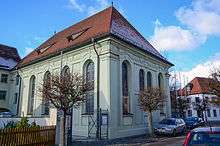Ichenhausen
Ichenhausen is a town in the district of Günzburg, in Bavaria, Germany. It is situated on the river Günz, 9 km south of Günzburg.
Ichenhausen | |
|---|---|
 Coat of arms | |
Location of Ichenhausen within Günzburg district  | |
 Ichenhausen  Ichenhausen | |
| Coordinates: 48°22′N 10°19′E | |
| Country | Germany |
| State | Bavaria |
| Admin. region | Schwaben |
| District | Günzburg |
| Municipal assoc. | Ichenhausen |
| Government | |
| • Mayor | Robert Strobel (CSU) |
| Area | |
| • Total | 34.22 km2 (13.21 sq mi) |
| Elevation | 489 m (1,604 ft) |
| Population (2018-12-31)[1] | |
| • Total | 9,148 |
| • Density | 270/km2 (690/sq mi) |
| Time zone | CET/CEST (UTC+1/+2) |
| Postal codes | 89335 |
| Dialling codes | 08223 |
| Vehicle registration | GZ |
| Website | www.ichenhausen.de |
History
Early history
The Lords of Roth had been feudal lord of the village since the early 14th century. In 1406 the town was granted market rights. In 1574 the barons of Stain von Rechtenstein zu Niederstotzingen acquired the village. With the 1806 Rhine Federal Act, the town came to the Kingdom of Bavaria and in 1818 became a patrimonial community through the communal ect, which lasted until 1843. In 1913 Ichenhausen was elevated to city status.
For centuries, Jewish families have lived in the village. They set up their own Jewish cemetery on the road to Krumbach and built a synagogue in 1687. This was renewed in 1781.
20th century
In 1933, 13% of the population was Jewish. At the November pogrom in 1938, the synagogue and the Jewish cemetery were destroyed, organized by the NSDAP. In a criminal trial before the Memmingen Regional Court in 1948, seven people were sentenced to prison for this reason.[2]
Many Jewish citizens moved to larger cities where they felt more secure in anonymity or emigrated abroad. Those left behind were deported and killed; 1942 (82 people to Lublin, 28 people to Theresienstadt) and 1943 (ten people to Auschwitz); only one woman survived.[3]
The collapse of the church tower
In 1964 the old Catholic church St. Johannes was extended and partly rebuilt. The church tower collapsed on Easter Monday in 1964 as a result of the reconstruction work. No injuries were sustained.
Districts
Ichenhausen is arranged into six districts:
- Ichenhausen
- Autenried
- Deubach
- Hochwang
- Oxenbronn
- Rieden an der Kötz
Sights
In Ichenhausen is the Bavarian School Museum, a branch museum of the Bayerisches Nationalmuseum. Another cultural asset in Ichenhausen is the former synagogue, which served as a fire station after the Second World War and was converted into a "House of Encounter" in the late 1980s. The Jewish Cemetery is also one of the sightseeings. In the Autenried district there is the Schloss Autenried from the beginning of the 18th century with a museum of paintings and a library.
 Former Synagogue, now House of Encounter
Former Synagogue, now House of Encounter Main street of Ichenhausen
Main street of Ichenhausen Schloßplatz with castle (left) and museum (right)
Schloßplatz with castle (left) and museum (right)
See also
- Synagogues of the Swabian type (Ichenhausen)
References
This article incorporates text translated from the article Ichenhausen from the German Wikipedia.
- "Fortschreibung des Bevölkerungsstandes". Bayerisches Landesamt für Statistik und Datenverarbeitung (in German). July 2019.
- Juden auf dem Lande – Beispiel Ichenhausen. Haus der Bayerischen Geschichte, München 1991, ISBN 3-927233-13-7, page 112 et seq.
- Juden auf dem Lande – Beispiel Ichenhausen. Haus der Bayerischen Geschichte, München 1991, ISBN 3-927233-13-7, page 122 et seq.
- Wilhelm Volkert (Hrsg.) (1983), Handbuch der bayerischen Ämter, Gemeinden und Gerichte 1799–1980 (in German), München: C.H.Beck’sche Verlagsbuchhandlung, p. 476, ISBN 3-406-09669-7
- Statistisches Bundesamt, ed. (1983), Historisches Gemeindeverzeichnis für die Bundesrepublik Deutschland. Namens-, Grenz- und Schlüsselnummernänderungen bei Gemeinden, Kreisen und Regierungsbezirken vom 27. 5. 1970 bis 31. 12. 1982 (in German), Stuttgart und Mainz: W. Kohlhammer, p. 775, ISBN 3-17-003263-1
External links
| Wikimedia Commons has media related to Ichenhausen. |
- Official website
- "Ichenhausen: History of the coat-of-arms" (in German). Haus der Bayerischen Geschichte.
- Ichenhausen: Official statistics compiled by the Bavarian State Office of Statistics (LfStat)
- Jewish history of Ichenhausen (German)